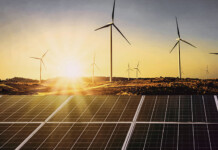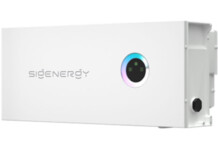CS Energy’s Greenbank Battery—the first large-scale battery in the South-East Queensland load centre—recently commenced commercial operations, providing a boost to the reliability and capability of the electricity grid.
The Greenbank Battery is CS Energy’s second grid-scale battery and follows the commissioning of the Chinchilla Battery on the Western Downs in 2024.
The 200MW/400MWh Greenbank Battery is located next to Powerlink Queensland’s Greenbank Substation in Logan. The battery typically stores surplus energy during low demand periods and then releases it back to the grid when demand is high, and has the capacity to power 66,000 homes for two hours in the evening peak before needing to recharge.
According to CS Energy head of renewables and firming operations Michael Johnstone, the $300 million battery project saw a peak workforce of 60 people during construction—plus around 50 jobs during Powerlink’s work connecting the battery to the grid. More than 46,000 hours of work went into the project.
“Batteries play a critical role in the energy transformation—they’re an ideal partner for intermittent renewables as they can store excess energy from the grid produced during sunny or windy periods and dispatch it later during the evening peak period when the sun goes down and demand increases,” Johnstone explains.
“Batteries are fast and flexible—they can be turned on and off in a fraction of a second to provide a rapid response when there is sudden gap in electricity supply. This helps to stabilise the grid and support system security and reliability.
“The Greenbank Battery enables our trading team to capitalise on energy supply fluctuations in the wholesale electricity spot market by purchasing energy when there is an oversupply, low demand, or low charge price; and selling it when there is high demand, undersupply, or high generation price.”
The battery’s site was strategically chosen by Powerlink following a feasibility study for its proximity to Powerlink’s transmission network in Greenbank, in the Logan City Council area.
“Having a battery at this location allows Powerlink to increase network capability, and stability by ensuring a reliable supply of high-voltage electricity is maintained to South-East Queensland, particularly the Logan, Gold Coast and South Brisbane areas connected to the Greenbank Substation.”
Related article: Qld’s Greenbank Battery begins commercial operation

Building the battery
Construction on the Greenbank Battery commenced in late 2023 and the battery commenced commercial operations in June 2025.
CS Energy partnered with a number of specialist companies for the Greenbank Battery build. These included construction partner Consolidated Power Projects and grid connection partner Powerlink Queensland, which installed a new transformer at the site to connect the battery to the substation.
Battery partner Tesla provided 108 Megapack 2XL units for the project. Each unit is an integrated AC block incorporating lithium iron phosphate (LFP) cells, safety systems, specialised control and monitoring software, a thermal management system, and inverters. The units are connected to the Powerlink 275kV network via 58 step-up transformers (33/0.48/0.48kV) and a single HV (275/33/33kV) power transformer.
“The Megapack is one of the safest battery energy storage systems of its kind. Units undergo extensive fire testing and include integrated safety systems and specialised monitoring software,” Johnstone says.
The battery is configured to operate in grid-forming mode and is tuned to provide quick and notable response to frequency and voltage deviations.
In addition to the traditional set of services typically provided by the utility-scale batteries in the National Energy Market (NEM), the Greenbank Battery is capable of operating in enhanced reactive power mode, supplying more reactive power to the grid than is expected by the Automatic Access Standard.
This allows the Greenbank Battery to boost network support when required. In addition, the team utilised a complete 3D BIM model and regular drone visual and lidar surveys to accurately map and monitor progress during the construction period.

Project challenges
With the Greenbank Battery being the first big battery built in a residential zone in Queensland, Johnstone says CS Energy took its responsibilities to the community very seriously.
“Extra steps were taken during the construction period to minimise the impact of noise, traffic, and dust on our neighbours,” he says.
“This included establishing remote continuous data collection of noise and dust monitoring stations at the site. We didn’t want to have a detrimental impact on the community, so we also constructed a noise wall for noise attenuation to protect nearby land and property owners.
“Our community engagement team was very proactive in addressing questions from the community about community impacts of construction and battery safety. We held regular community drop-in sessions—which were also attended by representatives from Powerlink and Tesla—and attended local events so that concerned community members could ask their questions to us directly.”
Related article: Huge transformer arrives for Greenbank Battery connection
Path to completion
Construction of the Greenbank Battery took three years in total, overlapping with the Chinchilla Battery project by approximately six months.
“Chinchilla came online just a few weeks before we took delivery of all 108 Megapacks for Greenbank,” Johnstone says.
“With Greenbank, there were many moving parts and a lot of logistic involved. Having the same project and construction teams that worked on the Chinchilla Battery meant that we had built excellent working relationships with Tesla, Powerlink, and Consolidated Power Projects.
“The significant efforts placed on quality assurance, commissioning, and operational readiness really paid off when the asset seamlessly moved from construction to safe and compliant operation on the network—the first day of operation was very memorable and rewarding for the team.”







